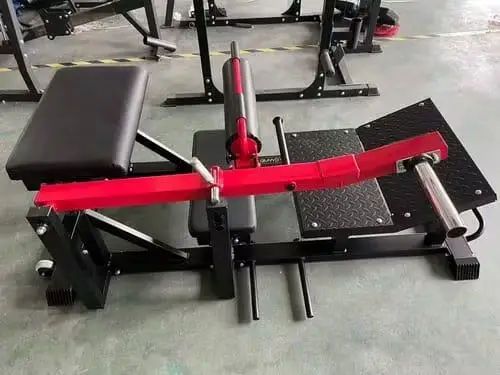In recent years, the hip thrust machine has become a staple in gyms and home workout setups. This versatile equipment is perfect for targeting the glutes and hip muscles, offering a more controlled and effective workout than traditional bodyweight exercises. If you’re interested in sculpting strong glutes, improving hip mobility, or adding variety to your lower-body routine, a hip thrust machine is a must-consider addition. This article delves into everything you need to know about gmwd fitness hip thrust machine, from their benefits to how to choose the right one for your needs.
What Is a Hip Thrust Machine?
A hip thrust machine is a fitness device designed to isolate and strengthen the glutes, hamstrings, and hip muscles. Unlike free-weight hip thrusts, a hip thrust machine offers stability and safety, making it ideal for all fitness levels. The machine typically features a padded seat or platform for your shoulders, along with a pad or roller to hold your hips down, allowing for a safe and effective thrusting motion.

Top Benefits of Using a Hip Thrust Machine
- Targeted Glute Activation
- Hip thrust machines are highly effective at isolating the gluteus maximus, one of the body’s largest and most powerful muscles. This targeted approach helps users achieve greater muscle activation compared to squats or lunges, leading to quicker strength gains and enhanced muscle definition.
- Enhanced Lower-Body Strength
- By focusing on the glutes and hamstrings, hip thrust machines help build strength essential for activities like running, jumping, and lifting. Improved lower-body strength can enhance performance in various sports and improve everyday mobility.
- Improved Hip Mobility
- Regular use of a hip thrust machine can increase hip flexibility and mobility, which is essential for reducing the risk of injuries. Strong, flexible hips contribute to better posture and support a range of physical activities.
- Reduced Lower Back Strain
- The design of hip thrust machines allows for a safe range of motion while minimizing pressure on the lower back. This is beneficial for individuals prone to lower back pain, offering a safer alternative to other lower-body exercises.
- Increased Stability and Control
- Unlike free-weight hip thrusts, the machine provides stability and control, allowing users to focus on perfecting their form without worrying about balancing weights. This is especially helpful for beginners and those recovering from injuries.
How to Use a Hip Thrust Machine
Using a hip thrust machine is straightforward, but proper technique is essential for maximizing results and avoiding injury. Here’s a step-by-step guide:
- Adjust the Machine:
- Position the seat or backrest to support your upper back comfortably. Adjust the height of the pad or roller so it sits just below your hips when seated.
- Position Yourself:
- Sit on the machine, leaning your upper back against the support pad, with feet flat on the floor and knees bent. The pad or roller should rest comfortably on your hips.
- Thrust Upward:
- Drive through your heels to lift your hips toward the ceiling, engaging your glutes and hamstrings. At the top of the movement, your torso and thighs should form a straight line.
- Control the Descent:
- Slowly lower your hips back down, maintaining tension in your glutes. Repeat the movement for the desired number of reps, focusing on form rather than speed.
- Add Weight (Optional):
- Some hip thrust machines come with adjustable resistance or space for additional weights. Start with a comfortable load and increase it gradually as your strength improves.
Choosing the Right Hip Thrust Machine
There are various hip thrust machines on the market, each designed to meet different needs and preferences. Here are some factors to consider when choosing the best machine for you:
- Space and Size
- If you’re setting up a home gym, consider the dimensions of the machine and the space available. Compact or foldable models can be a great choice for limited spaces.
- Weight Capacity
- Check the machine’s weight capacity, especially if you’re looking to lift heavy. Ensure it’s built to withstand your fitness level and future progression.
- Adjustability
- Look for a machine with adjustable seating, padding, and resistance options. Adjustable machines are more versatile and suitable for users of all sizes and fitness levels.
- Comfort and Padding
- High-quality padding on the hip roller and back support enhances comfort, especially during heavy lifting sessions. Durable, thick padding can make your workouts more enjoyable and help prevent discomfort.
- Portability
- For those who prefer a mobile workout setup, a lightweight or portable hip thrust machine is ideal. Some machines are easy to move and store, making them perfect for smaller spaces.
- Price and Warranty
- Prices vary widely based on features and build quality. Compare models within your budget, but don’t sacrifice quality for cost. Machines with solid warranties often indicate reliable quality.
Popular Hip Thrust Machine Exercises and Variations
A hip thrust machine allows for various exercises to target different muscle groups and add variety to your routine. Here are some effective variations:
- Single-Leg Hip Thrust
- Perform the hip thrust with one leg at a time to increase difficulty and engage stabilizing muscles.
- Weighted Hip Thrust
- Add resistance by placing a weight plate on your hips, or if your machine supports it, increase the load to intensify the workout.
- Pulse Reps
- At the top of the movement, pulse your hips up and down in small, controlled motions to maximize muscle burn.
- Pause Reps
- Hold the thrust position at the top for 2–3 seconds to increase time under tension and activate the glutes further.
Frequently Asked Questions About Hip Thrust Machines
1. Are hip thrust machines better than barbell hip thrusts?
Both barbell hip thrusts and hip thrust machines have unique benefits. Machines offer more stability, are beginner-friendly, and reduce the risk of improper form. Barbell hip thrusts, on the other hand, allow for a more dynamic range of motion and can be customized with free weights.
2. How often should I use a hip thrust machine?
For best results, use a hip thrust machine 2-3 times per week. This frequency allows adequate recovery while promoting consistent strength gains.
3. Can I build my glutes with a hip thrust machine alone?
Yes! Hip thrust machines are excellent for building glute strength and size. However, combining them with other lower-body exercises like squats, lunges, and deadlifts can lead to more balanced lower-body development.
4. Is a hip thrust machine suitable for beginners?
Absolutely. Hip thrust machines offer a stable platform for learning the correct form and building foundational glute strength, making them ideal for beginners.
Conclusion
A hip thrust machine is a powerful tool for anyone looking to develop glute strength, improve hip mobility, and achieve better lower-body control. With its unique benefits and ease of use, it’s a valuable addition to any workout routine, from beginners to advanced fitness enthusiasts. By understanding how to use a hip thrust machine correctly and selecting the right model, you’ll be well on your way to achieving your fitness goals and enjoying a stronger, more sculpted lower body.






